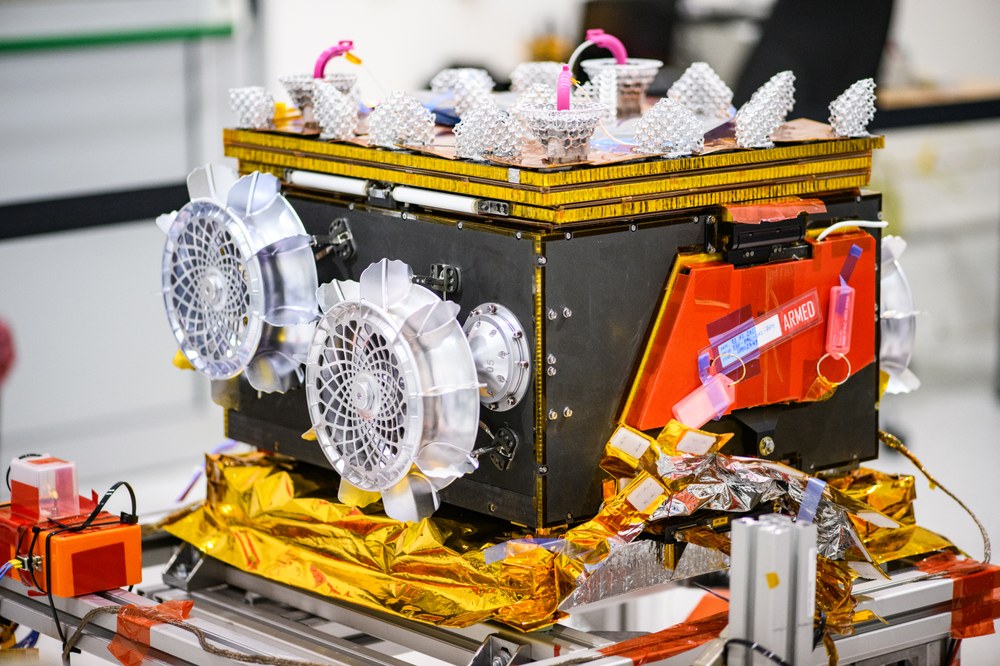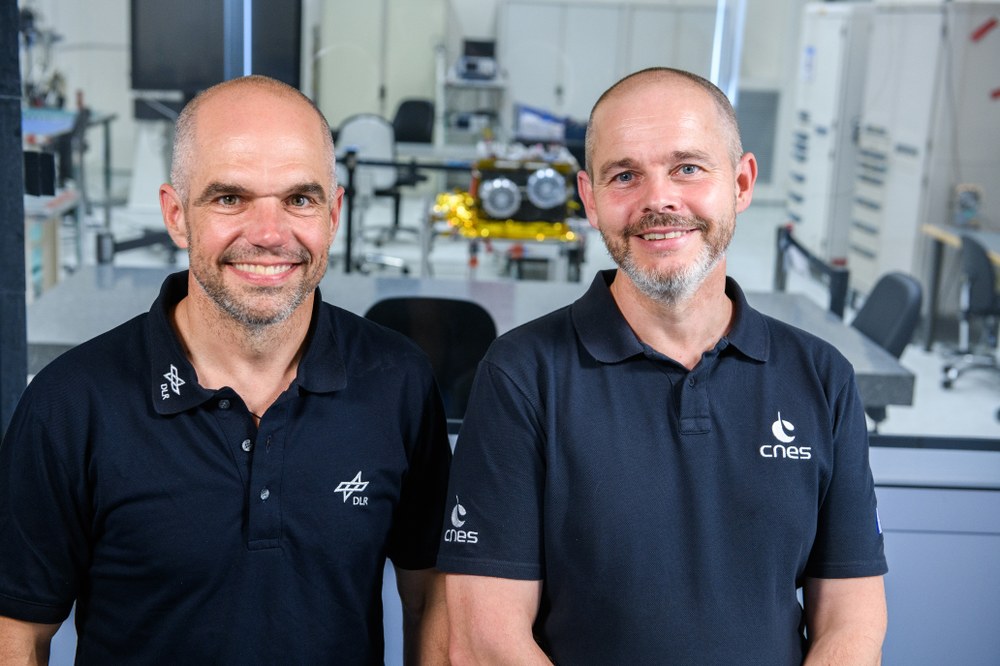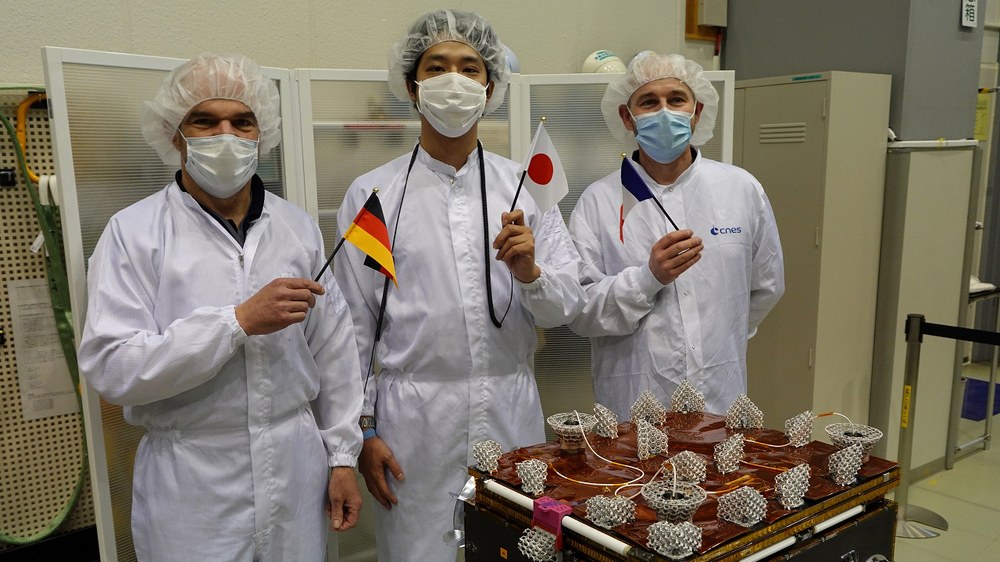The journey to the Martian moon Phobos begins


- +++ On 7 March 2024, DLR and CNES officially handed over the rover IDEFIX to the Japan Aerospace Exploration Agency, JAXA. The handover took place in Kamakura, Japan, at the Mitsubishi Electric Corporation (MELCO), where IDEFIX will be integrated as part of the assembly of the MMX spacecraft. The Martian Moons eXploration (MMX) mission is being prepared for its launch in 2026. This involves a comprehensive series of tests on the spacecraft and rover.++++
- As part of the MMX mission, the Franco-German rover IDEFIX will land on the martian moon Phobos.
- Japan and France are important strategic partner countries for DLR.
- Integration of the rover into the MMX mother craft will begin in Japan in February 2024.
- The launch of the MMX mission is currently scheduled for 2026.
- Focus: Spaceflight, robotics, exploration, Mars
The German-French rover IDEFIX travels to Japan and is expected to arrive there at the end of January. It is part of the Martian Moons eXploration (MMX) mission, which will explore both Martian moons under the leadership of the Japan Aerospace Exploration Agency, JAXA. The aim is to resolve the mystery surrounding the formation of Phobos and Deimos. As part of the mission, IDEFIX will perform the first ever landing on Phobos in order to explore its surface directly. The Japanese mother craft will collect samples from Phobos and bring them back to Earth. The German Aerospace Center (Deutsches Zentrum für Luft- und Raumfahrt; DLR) delivered the partially assembled rover and two instruments in 2022. Construction of IDEFIX was recently completed at the facility of the French space agency CNES in Toulouse. The integration of the rover into the MMX mother craft will begin in Japan in February 2024. The launch of the mission is currently scheduled for 2026.

Video: Together for IDEFIX
Your consent to the storage of data ('cookies') is required for the playback of this video on Quickchannel.com. You can view and change your current data storage settings at any time under privacy.
"Together with our French partners at CNES, we are delighted that IDEFIX is now making its way to Japan to travel to the martian moon Phobos on board the MMX mission in close cooperation with JAXA," said Anke Kaysser-Pyzalla, Chair of the DLR Executive Board. "Japan and France are important strategic partner countries for DLR in almost all of our research areas, and the joint work of JAXA, CNES and DLR on the MMX mission is an excellent example of what we can achieve together."
"We are very happy that IDEFIX is now traveling to Japan. This is another important milestone in the fruitful cooperation between CNES, JAXA and DLR on the MMX mission. This mission will lead to major advances in the knowledge of the Solar System, and we are proud to have built this partnership with Japan and Germany," says Philippe Baptiste, President of CNES.
Following its completion in July 2023, IDEFIX successfully completed extensive space qualification tests, including with regard to its functionality and its ability to withstand the vibrations of the launch and the extreme temperature changes on Phobos. The task now is to ensure the transport of the rover in the best possible way. For safety reasons, it will travel with almost completely discharged batteries. The first task for the DLR and CNES reception team in Japan will be to charge the batteries in order to maintain their performance. This will be followed by an extensive functional check and finally the handover to JAXA.
The German-French IDEFIX team is proud of what they have achieved. "The special thing about this rover for the MMX mission is its extremely compact design. IDEFIX essentially has all the elements of a fully-fledged scientific rover, but it only weighs 25 kilograms thanks to its highly integrated construction. This is crucial if it is to survive the impact on Phobos unharmed," explains Markus Grebenstein, the DLR Project Manager for IDEFIX.

From Japan into space
With the integration of the rover into the MMX mother craft, the final preparations for the flight to Mars and its moons will begin in Kamakura, Japan. "I have personally 'met' IDEFIX several times in Europe and we at JAXA are very pleased to welcome it to Japan, where the MMX spacecraft is currently being developed and prepared for launch," says MMX Project Manager Yasuhiro Kawakatsu. "Even though the launch has been postponed from 2024 to 2026, this does not change the importance of the mission or the impact it will have with the world's first sample return from the martian system. We will continue to work hard to finalise the MMX spacecraft to meet our new launch date in 2026. We will ensure that IDEFIX is the first to reach the surface of Phobos as the 'First Penguin' (risk taker), even before the MMX spacecraft lands to collect samples."
The mission sequence
After an approximately one-year journey, the MMX spacecraft, consisting of the exploration module, return module and sample retrieval capsule, will reach Mars in 2027 and enter orbit. The eight scientific instruments of the exploration module will then begin mapping and characterising the surfaces of Phobos and Deimos. The rover will land on Phobos in free fall from a height of 40 to 100 metres above the surface. Once it has landed, it will upright itself autonomously and be ready for the three-month mission phase. "The biggest challenge for IDEFIX is that it has to carry out many operations – particularly the uprighting after landing on Phobos – fully autonomously in order to survive," emphasises Stéphane Mary, CNES Project Manager for IDEFIX. "It wouldn't survive if it waited for commands from Earth to arrive."
On the surface it will then search for and analyse areas of scientific interest on Phobos. In doing so, IDEFIX will be breaking new technological ground, as no exploration vehicle with wheels has ever travelled on a celestial body with less than a thousandth of the Earth's gravitational pull. At the end of the MMX mission, surface samples will be collected by the mother craft and sent back to Earth.
The Martian moons Phobos and Deimos are the only two natural satellites in the inner Solar System apart from Earth's own Moon. They are much smaller than Earth's natural satellite and, due to the low gravitational forces, are not spherical but irregular in shape. The largest dimension of Phobos is just under 27 kilometres, while Deimos is only 15 kilometres across.
Related links
About the Martian Moons eXploration (MMX) mission
MMX is a mission of the Japanese space agency JAXA with contributions from NASA, ESA, CNES (the French space agency) and DLR. CNES and the DLR are jointly contributing a 25-kilogram rover. The German-French MMX rover is being designed and built under the joint leadership of the two partners.
In particular, DLR is responsible for the development of the rover chassis, including the carbon-fibre reinforced structure, as well as the entire uprighting and locomotion system. DLR is also contributing the connection and separation system to the mother craft and providing a Raman spectrometer and a radiometer as scientific experiments. These will analyse the surface composition and texture on Phobos.
CNES is making significant contributions with camera systems for spatial orientation and exploration on the surface, as well as for the study of mechanical soil properties. CNES is also developing the rover's central service module, including the on-board computer and the power and communications system. After the launch of the MMX mission, the rover will be operated by control centres at CNES in Toulouse (France) and at DLR in Cologne (Germany).
At DLR, under the leadership of the Institute of Robotics and Mechatronics, the institutes of System Dynamics and Control, Lightweight Systems, Space Systems, Optical Sensor Systems, Planetary Research and Software Technology, and the Microgravity User Support Center (MUSC) are all involved in the mission.
The MMX mission is a continuation of an already long-standing successful cooperation between JAXA, CNES and DLR. It follows on from the previous mission, Hayabusa2, in which JAXA sent a spacecraft to the asteroid Ryugu with the German-French MASCOT lander on board. On 3 October 2018, MASCOT landed on Ryugu and sent spectacular images of a landscape covered with boulders and rocks, and almost no dust. Hayabusa2 collected samples from Ryugu and brought them back to Earth on 6 December 2020.

